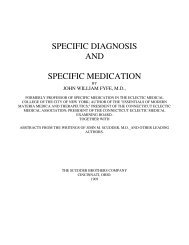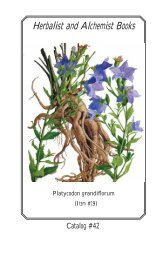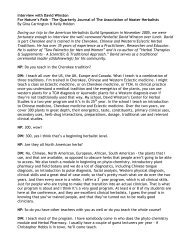MEDlCINAL PLANTS OF JAMAICA. PARTS 1 & 11.
MEDlCINAL PLANTS OF JAMAICA. PARTS 1 & 11.
MEDlCINAL PLANTS OF JAMAICA. PARTS 1 & 11.
You also want an ePaper? Increase the reach of your titles
YUMPU automatically turns print PDFs into web optimized ePapers that Google loves.
OPUNTIA TUNA Mill. Tuna: Indian Fig; Prickly Pear.<br />
The 'leaves' (stems) of tuna are used to make a decoction used 'to keep away inflammation inside'. The<br />
baked sliced stem is applied to swellings and bound on the head and put in the bed for vomiting and fever. For<br />
headaches the sliced stem is bound on the head and for soreness, pains and constipation it is rubbed with salt<br />
and applied as a poultice. The stem is said to contain calcium oxalate and calcium malate. It also produces tuna<br />
gum which contains a substance called bassorin. The fruit is astringent. (8, I5, 26).<br />
CAESALPINIOIDEAE*<br />
CAESALPINIA BONDUC Roxb. Yellow Nicker: Nicker; Bonduc.<br />
C. BONDUCELLA Flem. Grey Nicker: Nicker; Bonduc.<br />
Although grey nicker is considered superior, the seeds of both species are dried and ground and used<br />
like coffee to prepare a drink which is thought useful for kidney trouble, diabetes and high blood pressure. In<br />
India the seeds of C. bonducella are regarded as tonic and anti-periodic. They are also said to be emetic and<br />
anthelmintic and were at one time used in Dominica as a diuretic and cathartic. The seeds contain a bitter<br />
principle, bonducin, which is not a glucoside but is probably of a resinous nature. Recent data indicate that<br />
alkaloids and tannins are absent but that saponin (about which earlier data were contradictory) is present.<br />
Also present are sugars, starch, fatty oil and, it is said, a phytosterol glucoside which on cleavage gives<br />
phytosterol and a reducing sugar. (3, 8, 10, 15, 24, 26, 27).<br />
C. CORIARIA Willd. Divi-divi: Libi-dibi.<br />
The fruits contain 30 to 50 per cent tannin and tannic acids. They are astringent and are used to make a<br />
gargle for sore throat. A decoction of the leaves and stems is similarly used and also for stomach-ache. The pod,<br />
powdered, is also said to be tonic and antiperiodic. (8, 27).<br />
CASSIA OBOVATA Collad. Jamaica Senna: Port Royal. Dog, Senegal. Tripoli, or Italian Senna: Senegal<br />
Cassia.<br />
Stated to have been introduced into Jamaica in the seventeenth century by a slave, this senna is still said<br />
to be used here as a substitute for the official sennas. At one time it was official in the British Pharmacopoeias<br />
as an ingredient of Alexandrian senna. Both pods and leaves contain oxymethylanthraquinone (1.1 to 1.15 per<br />
cent in the leaves and about 1.2 per cent in the pods) and also probably emodin. At one time it was cultivated on<br />
the Palisadoes with a view to exporting the senna. In Africa in addition to its use as a cathartic the leaves<br />
are used as a dressing for burns and ulcers. (3, 7, 10, IS, 19, 23, 26, 27).<br />
C. OCCIDENTALIS L. Wild Senna: Dandelion; Stinking Weed or Wood; John Crow Pea: Wild<br />
Coffee.<br />
The seeds of this species are dried, beaten up, and used as a coffee substitute. The drink prepared from<br />
them has a reputation for usefulness in kidney and bladder troubles and malaria. it is also said to be useful for<br />
palpitations and high blood pressure. The leaves are probably used for constipation, pain, fever and colds. The<br />
root is said to be diuretic and used for colds. The seeds contain tannic acid, mucilage, fatty oil. emodin and a<br />
toxalbumin. The roots, leaves and pods contain traces of oxymethylanthraquinone. Similar uses of the plant are<br />
found in Africa. C. ligustrina L. and possibly other cassia species also go under the name of dandelion and are<br />
used in the same way. (2, 3, 7, 8, 10, 14, 15, 19, 24, 25, 26, 27).<br />
HAEMATOXYLUM CAMPECHIANUM L. (Campeachy) Logwood.<br />
Beckwith says that the chipped bark is used with sugar to make a drink. The wood and bark were<br />
formerly used by Jamaican medical men as an astringent for diarrhoea and dysentery.<br />
*See also LEGUMINOSAE.







